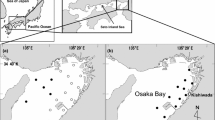Abstract
The occurrence and distribution of eggs and larvae of anchovy, Engraulis japonicus, in Jeju Strait, Korea from May to November 2002 were investigated, and the relationships between the abundances of anchovy eggs and larvae and the oceanographic conditions, including meteorological data, were analyzed. During the sampling periods, the anchovy eggs occurred from May to October and about 95% of total egg abundance occurred in only two months from July to August, suggesting that the main spawning season of anchovies is confirmed in summer from July and August in Jeju Strait. The spawning area of anchovies gradually moved to the southern part of the survey area with time. The predominant anchovy larvae collected in this study were mostly smaller than 16.0 mm TL. Correlation analysis and multiple regression analysis showed that the anchovy egg abundance in the study area depended strongly on the wind conditions, especially less than 10 m/s, and increasing water temperature. Salinity variations also had significant effects on the abundance of anchovy larvae.
Similar content being viewed by others
References
Chang, S. D., S. Y. Hong, C. K. Park, P. Chin, B. G. Lee, T. Y. Lee, Y. J. Kang and Y. Gong (1980): Studies on the migration of anchovy Engraulis japonica in Korean waters. Publ. Inst. Mar. Sci. Nat. Fish. Univ. Busan, 12, 1–38.
Goto, T. and M. Hirai (1999): Horizontal distribution of clupeoid eggs in relation to the distribution of water masses in the vicinity of Noto Peninsula in the Japan Sea, May 1989–1993. Bull. Japan Sea Natl. Fish. Res. Inst., 49, 81–96.
Hayashi, S. (1966): A note on the biology and fishery of the Japanese anchovy Engraulis japonica (Houttuyn). CalCOFI Rep., 11, 44–57.
Johnson, R. A. and D. W. Wichern (1988): Applied Multivariate Statistical Analysis. Prentice Hall, London, 594 pp.
Kawaguchi, K., Y. Yamashita and A. Hayashi (1990): Some aspects of spawning of the reared Japanese anchovy (Engraulis japonicus, H.) in relation to the photoperiod, water temperature and starvation. Bull. Japan. Soc. Fish. Oceanogr., 54, 364–372.
Kim, J. Y. (1992): Relationship between anchovy, Engraulis japonica, egg and larval density and environmental factors in the eastern waters of Korea. Bull. Kor. Fish. Soc., 25, 495–500.
Kim, J. Y. and Lo, N. C. H. (2001): Temporal variation of seasonality of egg production and the spawning biomass of Pacific anchovy, Engraulis japonicus, in the southern waters of Korea in 1983–1994. Fish. Oceanogr., 10(3), 297–310.
Kim, K. and S. H. Lee (1991): Vertical homogeneous water along the west coast of Jeju Island. J. Kor. Soc. Oceanogr., 17, 59–68.
Lasker, R. (1975): Field criteria for survival of anchovy larvae: the relation between inshore chlorophyll maximum layers and successful first feeding. Fish. Bull. U.S., 73, 453–462.
Lasker, R. (1981): Factors contributing to variable recruitment of the northern anchovy (Engraulis mordax) in the California current: contrasting years, 1975 through 1978. Rapp. P.-V. Reun. Cons. int. Explor. Mer., 178, 375–388.
Lee, M. A., K. T. Lee and H. C. Ou (1990): The larval anchovy fishing ground formation in relation to osmotic pressure changes of the coastal waters along southern Taiwan. J. Fish. Soc. Taiwan, 17, 233–245.
Lee, S. J. and Y. B. Go (2003): Development of trunk musculature and fins in the early growth of anchovy, Engraulis japonica. Kor. J. Ichthyol., 15, 45–52.
Lim, J. Y. and I. S. Ok (1977): Studies on the occurrence and distribution of eggs and larvae of anchovy in the Korean waters. Bull. Nat. Fish. Res. Dev. Agency, 16, 73–86.
Mio, S. and K. Tsujino (1995): Effects of hydrographic condition on fishing condition of sardine and anchovy in the Osaka Bay. Bull. Japan. Soc. Fish. Oceanogr., 59, 115–122.
Mitani, I. (1990): Biological studies on the larvae of Japanese anchovy, Engraulis japonica Houttuyn, in Sagami Bay. Ph.D. Thesis, University of Hokkaido, 213 pp.
Mitani, I. and T. Hasegawa (1988): The shirasu fishing ground formations and sea surface salinity change in Sagami Bay. Bull. Japan. Soc. Fish. Oceanogr., 52, 297–303.
Nakata, H., S. Kimura, Y. Okazaki and A. Kasai (2000): Implications of meso-scale eddies caused by frontal disturbances of the Kuroshio Current for anchovy recruitment. ICES J. Mar. Sci., 57, 143–152.
Nojima, M. and Y. Nakamura (1988): Biological study on the shirasu in the adjacent waters to Satsunan sea region. Bull. Japan. Soc. Fish. Oceanogr., 52, 248–252.
Odate, S. (1957): Studies on the larval fish of the Japanese anchovy, Engraulis japonica (Houttuyn), in the north-eastern sea area of Japan. Bull. Tohoku Reg. Fish. Res. Lab., 9, 111–128.
Pang, I. C. and K. H. Hyun (1998): Seasonal variation of water mass distributions in the Eastern Yellow Sea and the Yellow Sea Warm Current. J. Kor. Soc. Oceanogr., 33, 41–52.
Pang, I. C., H. K. Rho and T. H. Kim (1992): Seasonal variations of water mass distributions and their cause in the Yellow Sea, the East China Sea and the adjacent seas of Cheju Island. Bull. Kor. Fish. Soc., 25, 151–163.
Park, Y. H. (1985): Some important summer oceanographic phenomena in the East China Sea. J. Kor. Soc. Oceanogr., 20(1), 12–21.
Parsons, T. R., Y. Maita and C. M. Lalli (1984): A Manual of Chemical and Biological Methods for Weawater Analysis. Pergamon Press, Oxford, 173 pp.
Peterman, I. and M. J. Bradford (1987): Wind speed and mortality rate of a marine fish, the northern anchovy, Engraulis mordax. Science, 235, 354–356.
Smith, P. E. and R. Lasker (1978): Position of larval fish in an ecosystem. Rapp. P.-V. Reun. Cons. Int. Explor. Mer., 173, 77–84.
Uehara, S. (1962): Fishery oceanography around Enshu Nada off the central Pacific coast of Honshu—I. Oceanographic condition for skipjack and shirasu fisheries. Bull. Tokai Reg. Fish. Res. Lab., 34, 55–66.
Author information
Authors and Affiliations
Corresponding author
Rights and permissions
About this article
Cite this article
Lee, SJ., Go, YB. Occurrence and Distribution of the Eggs and Larvae of Anchovy, Engraulis japonicus, in Jeju Strait, Korea, with Descriptions of Environmental Characteristics. J Oceanogr 61, 603–611 (2005). https://doi.org/10.1007/s10872-005-0068-5
Received:
Revised:
Accepted:
Published:
Issue Date:
DOI: https://doi.org/10.1007/s10872-005-0068-5




